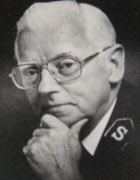2008 Lower Section National Finals: Test piece review - My Strength, My Tower
23-Sep-2008Paul Hindmarsh looks more closely at Dean Goffin's masterful work and wonders if the added extra touches will make it even better?
 Second Section: Rhapsodic Variations ‘My Strength, My Tower’ by Dean Goffin
Second Section: Rhapsodic Variations ‘My Strength, My Tower’ by Dean Goffin
Sir Dean Goffin (1916 – 1984) was a remarkable Salvationist composer. A New Zealander, he came from a musical Salvationist family. His father was a composer of marches. Dean became a bandmaster at the tender age of 19. He was the first major Salvationist composer to benefit from a University education, graduating from the University of Otago in 1950.
He served in North Africa and the Middle East during the Second World War, forming the band of the 20th Infantry Battalion of the 4th Brigade. His celebrated Rhapsody in Brass was sketched in 1942 while he was on active war service in North Africa.
Shortly after graduating, he trained to become a full-time SA officer, serving first in his native land before being commissioned as National Bandmaster (1956-60) and then Secretary for Bands and Songsters (1960 – 66) in the British Territory. He then returned to New Zealand, where is served until his death.
Best music
His best music - those works where he revealed something of his own personality – reveal a love of counterpoint and classical forms. Not every work was successful. He found it problematic reconcile his love of contrapuntal development with the march form in Crusaders, but his understanding of formal logic paid dividends in his early meditation The Light of the World.
His masterwork is unquestionably the Rhapsodic Variations which he composed as a sequel to Rhapsody in Brass. This work was conceived as a test piece over 50 years ago, but remained in manuscript when Goffin was commissioned as an Officer in the SA. At that time, this precluded any future for the work in the wider musical arena, so to facilitate its eventual publication ( by the Salvation Army in January 1963), Goffin adapted the gentle, modal theme as an anthem, setting John Wesley’s translation of a hymn by Johann Scheffler which begins, ‘Thee will I love, my strength, my tower’.
Technical challenges
The considerable technical challenges faced by the players in mastering this music are embedded in an intricate web of strict counterpoint and free imitation. To lift the music off the page, players, guided by their ears and the conductor, need to be aware how their part fits into this fabric and how they should match in dynamic and phrasing.
Even in the apparently simple theme, one can hear a fine contrapuntal mind at work in the way that the central climax builds through imitative voicing – a technique which Goffin extends into the concluding paragraph and how in the concluding paragraph. Nothing should be overstated. The music should unfold naturally.
Five variations
The five variations that follow are not of the elaborative ‘air varie’ kind. Each has its own character, rather like Brahms’ masterpiece the Variations on the St. Antony Chorale. The first variation is a graceful and elegant miniature. Tempo needs to be measured, but the imitative writing needs to be integrated and to flow.
It should be approached like chamber music. It leads directly into a fiery scherzo, which increases the tempo somewhat. But beware: if it goes too fast the clarity of the contrapuntal lines will be lost. This music is full of energy, power and drive, but the composer also asks for strength of attack, which should not be sacrificed to excessive speed in my view.
Central Lento
The central Lento could not provide a greater contrast. This movement is all about subtlety – a liquid, free-flowing rubato in the arabesques of the solo cornet and euphonium, supported by well-balanced, atmospheric and tuneful accompaniments from the muted instruments and the enhanced percussion.
The way the basses attack the forte-piano starts and the accents that follow will be crucial to the bell-like sound which Goffin seems to be creating. In his original manuscript the composer indicated that these attacks should be rather gentle.
Miracle
The Passacaglia that follows is a miracle of contrapuntal invention. Over the measured tread of the repeating bass line, Goffin weaves all manner of intricate lines. As the movement unfolds the ‘ground bass’ is turned up-side down, played at double speed against a half-speed version. The considerable energy that is unleashed grows out of the way Goffin weaves his web of musical lines.
It is a masterly moment which will require a great deal of thought and preparation to bring off . The work comes to a brilliant conclusion with a sparkling and very fast dance in a swift duple time. Clarity of articulation, smooth phrasing where required and a full dynamic range will be essential.
Deft touches
For the 2008 Nationals, Brian Bowen has added some deft touches of additional percussion, as well as constructing a repiano cornet part from the elements of the solo and second cornet lines. Bowen’s addition of timpani is logical. The new glockenspiel parts appear tasteful and restrained.
The tubular bell notes in the rhapsodic lento seem to take greater liberties with Goffin’s original, but should sound well. It will be interesting to hear whether the repeated tam-tam strikes add to or detract from the air of mystery that Goffin creates in this movement.
Will the single phrase given to the xylophone as the contrapuntal drama heats up in Variation 4 be worth the wait?
My Strength, My Tower is one of the finest works published by the Salvation Army. It will present a stern test of technique and musicianship to all the competing bands.
Paul Hindmarsh















